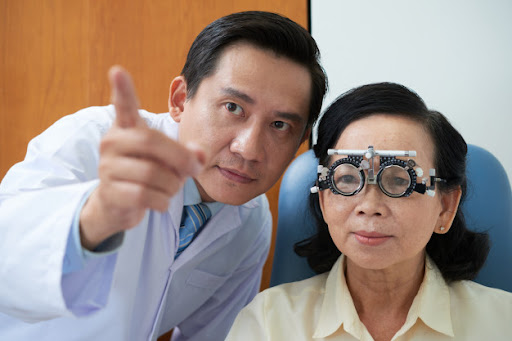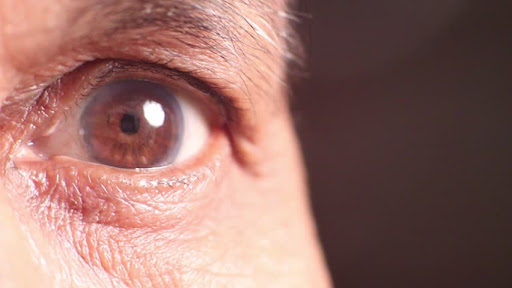How Does Age-Related Macular Degeneration (AMD) Occur?
AMD occurs with aging, where there is damage to the macula. The macula is a part of the retina in the eye that allows for sharp and straight-ahead vision. AMD can either happen progressively and slowly or at a faster rate in some people.
The Symptoms of Age-Related Macular Degeneration (AMD)
Signs of AMD get easily overlooked and start becoming more noticeable as the condition worsens. The main symptom of AMD is blurry vision. Other symptoms include dark or blurred areas that arise as you’re looking straight-ahead and worsened colour perception.
Who May Be at Risk for Age-Related Macular Degeneration (AMD)?
You are more likely to contract the disease if you:
-
Are overweight
-
Smoke
-
Are over 50 years old
-
Have a family history of AMD
-
Have high blood pressure (Hypertension)
-
Consume a lot of food that are high in saturated fat
-
Are at risk of heart diseases
The Types & Stages of Age-Related Macular Degeneration (AMD)
There are 2 types of AMD:
-
Wet AMD – Also known as Neovascular AMD. Those diagnosed with wet AMD lose their vision at a faster rate compared to those diagnosed with dry AMD. Wet AMD happens when abnormal blood vessels that grow under the retina leak fluids or blood into the retina. This then causes scarring on the macula which leads to the loss of your central vision, making sight blurry.
-
Dry AMD – Dry AMD or Atrophic AMD is far more common as compared to wet AMD. Similar to wet AMD, it occurs with age. However, with dry AMD, the macula gets thinner with age and little clumps of protein known as drusen forms on the macula, which causes the loss of your central vision. AMD tends to occur in 3 stages – classified as early, intermediate, and late. While dry AMD progresses throughout all 3 stages, wet AMD only presets at the late stage.
Diagnosing Age-Related Macular Degeneration (AMD)
AMD can be diagnosed through a regular eye screening that is painless and simple. Eye drops that dilate the pupil are administered into the eye to help the ophthalmologist examine the eyes for any signs of AMD such as the formation of drusen.
If the patient shows signs of AMD, the ophthalmologist will recommend undergoing a test known as Optical Coherence Tomography (OCT) that allows for the ophthalmologist to take internal photographs of the eye. The photographs will point on the exact location of the damage on the macula as well as help determine the type and stage of the condition.
Treatments for Age-Related Macular Degeneration (AMD)
There is no cure for AMD, however, treatment can help slow the disease from worsening and in turn, preventing the patient from losing too much of their vision. Here are some of the treatment options for AMD that Eyecentric by SJMC offers:
-
Laser therapy – High energy laser light that will destroy the abnormal growth of blood vessels that grow under the retina.
-
Submacular surgery – In rare occasions, a surgical procedure known as submacular surgery may be used as treatment to remove the abnormal blood vessels.
-
Anti-angiogenesis injections – Administering anti-angiogenesis inhibitors such as bevacizumab (Avastin), ranibizumab (Lucentis), and aflibercept (Eylea) can help block the fluid and blood leakage from the blood vessels.
-
Low vision aids – Devices that incorporate electronic systems or special lenses that create larger and clearer images of things that are nearby.
Preventing Age-Related Macular Degeneration (AMD)
Studies have shown that dry AMD can be slowed down or prevented by taking supplements or incorporating foods rich in:
-
Zinc
-
Vitamin C
-
Vitamin E
-
Copper
-
Lutein
-
Zeaxanthin
Eye healthy foods such as fish, dark leafy greens, yellow fruits along with a nutrient-rich, balanced diet have been proven to be beneficial for people diagnosed with AMD.
Be Aware of Your Eye Health with Eyecentric by SJMC
Awareness on the importance of regular eye screenings is key to preventing Age-Related Macular Degeneration (AMD) as well as other eye diseases from developing or progressing. SJMC welcomes all to include regular eye screenings as part of their medical routine to maintain their eye health while keeping themselves safe from eye diseases and disorders.
At Eyecentricm, situated at Subang Jaya Medical Centre (SJMC), our team of highly skilled medical practitioners include experienced ophthalmologists and eye surgeons who provide patients with the best treatments for any disorders and diseases related to the eye.
SJMC holds a strong belief in caring for our patients and ensuring patients receive only the best when it comes to diagnosing symptoms and treating the issue. Eyecentric by SJMC also provides regular eye screenings to endorse the importance of maintaining one’s eye health with regularity.
Meet our Specialist
Dr Ronald Arun Das
Designation
Consultant Ophthalmologist and Vitreo Retinal Surgeon
Dr V. Ulagantheran Viswanathan
Designation
Consultant Ophthalmologist and Vitreo Retinal Surgeon



 – 1.png)
 – 4.png)

